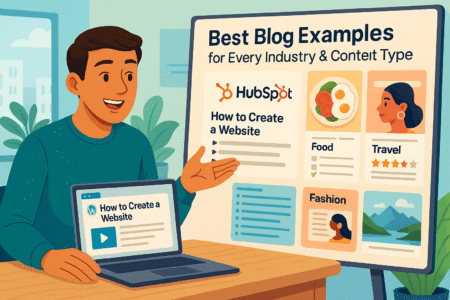Table of Contents
Why blogging is good for business? In today’s digital landscape, businesses need to connect with their audience, showcase expertise, and stand out in a competitive market. This article dives into seven compelling reasons why blogging can be a game-changer for your business.
1. Boosting Brand Visibility With Blogging
Blogging is a powerful tool to elevate your brand’s visibility, making it easier for your audience to discover and engage with your business. By publishing consistent and valuable content, you can position your brand as a trusted name in your industry.
How Blogging Enhances Online Presence
A blog extends your online footprint, offering more opportunities for your audience to find you. By optimizing posts for search engines, your blog becomes a traffic magnet, attracting visitors searching for solutions, insights, or inspiration in your niche.
Blogging also helps businesses reach specific demographics through targeted topics. When you write content addressing your audience’s needs, they’re more likely to engage. This creates a lasting connection, fostering loyalty.
Each post acts as a digital asset that remains online for readers to discover. As you accumulate blog entries, your online presence grows exponentially, further boosting visibility.
Search engines prioritize fresh, engaging content. Regular blogging signals that your site is active, relevant, and deserves higher rankings. Over time, this steady traffic can translate into more conversions and stronger brand recognition.
By sharing your blog posts on social media, you amplify your reach even further. This multi-platform presence ensures that your audience can find you wherever they prefer to engage.
Building Authority Through Valuable Content
Sharing valuable content establishes your business as an expert in your field. When your blog educates or inspires, readers view you as a trusted source they can rely on.
By addressing frequently asked questions, you demonstrate a deep understanding of your industry. This not only draws readers but encourages them to seek your expertise for their challenges.
Incorporating research, case studies, and data-driven insights strengthens your authority. This credibility makes readers more likely to recommend your brand to others, increasing organic growth.
Consistency is key to maintaining authority. A steady stream of insightful blog posts keeps your audience engaged and reinforces their perception of your business as a thought leader.
Writing authentically and offering genuine advice fosters trust. When readers feel they’re getting actionable value, they’re more likely to follow your guidance and interact with your brand.
Driving Organic Traffic With SEO Strategies
Blogging opens the door to increased organic traffic by implementing strategic SEO practices. Keyword research helps identify terms your audience searches for, ensuring your content is aligned with their needs.
Structuring your posts with clear headings, subheadings, and concise paragraphs improves readability. Search engines reward blogs that are user-friendly, further boosting your rankings.
Incorporating long-tail keywords allows you to target specific queries. These phrases have less competition and attract readers closer to making purchasing decisions.
Optimized images, meta descriptions, and internal linking enhance your blog’s visibility. These small details create a more comprehensive SEO strategy that drives consistent traffic.
Creating evergreen content ensures long-term traffic generation. Posts that remain relevant provide ongoing value, keeping readers coming back and engaging with your brand.
Strengthening Brand Recognition Over Time
Consistent blogging ensures that your brand remains at the forefront of your audience’s mind. Over time, this recognition builds trust and loyalty.
When readers encounter your logo, tone, or message repeatedly, they begin to associate it with quality and reliability. Blogging helps create that memorable connection.
Your blog serves as a platform to share your brand’s story, values, and mission. This transparency helps readers relate to your business on a personal level.
Every post is an opportunity to reinforce your unique voice and positioning. By staying consistent, your audience knows exactly what to expect when they interact with your content.
Expanding your blog’s reach through social media and email campaigns ensures your brand stays visible. This multi-channel approach strengthens recognition and drives sustained growth.
2. Increasing Customer Engagement Through Blogging

Blogging is an excellent way to foster deeper connections with your audience. By providing meaningful and relatable content, you encourage readers to interact, share, and build a relationship with your brand, creating long-term loyalty.
Creating Content That Resonates With Your Audience
Understanding your audience’s needs is the foundation of resonant content. When you write about their pain points or aspirations, you naturally draw their attention.
Engaging headlines and intros hook readers immediately. Once they’re intrigued, relevant and actionable information keeps them reading and exploring your offerings.
Personal stories and experiences can make your posts relatable. Readers appreciate content that feels genuine and reflects their journey, encouraging them to share their own thoughts.
Visual elements such as infographics or videos enhance engagement. These formats break up text and cater to different learning preferences, making your blog more accessible.
Interactive elements like quizzes or polls can transform passive readers into active participants. These tools create a dynamic user experience that fosters deeper connections.
Encouraging Interaction Through Blog Comments
Inviting feedback in your posts shows readers that their opinions matter. A friendly tone encourages comments and fosters community engagement.
Responding to comments promptly and thoughtfully turns one-time visitors into loyal followers. This interaction humanizes your brand and builds trust.
Comments can provide insights into your audience’s preferences, helping you refine your future content strategy. This responsiveness strengthens your relevance and authority.
Readers are more likely to engage when they see others doing so. Cultivating an active comment section creates a ripple effect that amplifies your blog’s reach.
Encouraging readers to share their own experiences fosters a collaborative environment. This exchange of ideas enriches your blog’s community and boosts loyalty.
Sharing Blog Posts Across Social Media Platforms
Social media amplifies your blog’s visibility by connecting with a broader audience. Sharing your posts ensures they reach readers where they spend most of their time.
Customizing your captions for each platform enhances engagement. Tailoring your message to fit the audience on Instagram, LinkedIn, or Facebook ensures better reception.
Scheduling posts consistently creates anticipation and drives traffic. Readers begin to expect your content, boosting loyalty and regular engagement.
Collaborating with influencers or industry partners can expand your blog’s reach. Their audience trust can help introduce your business to new potential customers.
Monitoring analytics on social media provides insights into what works. Use this data to refine your sharing strategy and maximize blog performance.
Improving Trust With Informative Content
Trust grows when readers find your content helpful and accurate. Providing actionable tips, backed by research or examples, builds credibility.
Transparent posts about your brand’s processes or challenges create authenticity. Readers appreciate honesty and feel more connected to your story.
Content that aligns with your audience’s values fosters stronger trust. When readers see their priorities reflected in your writing, they feel understood.
Addressing common misconceptions in your industry positions you as a reliable source. This proactive approach prevents misinformation and strengthens authority.
Consistent, high-quality content reassures readers that your brand is dependable. When they know they can rely on you, trust naturally follows.
3. Generating Quality Leads And Conversions
Blogging is an effective strategy for turning visitors into leads and leads into loyal customers. By creating engaging content that aligns with your audience’s interests, you can build trust, foster relationships, and encourage meaningful actions that lead to conversions.
Using Call-To-Actions In Blog Posts Effectively
Call-to-actions (CTAs) are the bridge between blog readers and conversions. Crafting CTAs that are clear, enticing, and relevant can guide readers toward actions like signing up for newsletters, downloading resources, or purchasing products.
CTAs should be strategically placed within blog posts to flow naturally with the content. A well-placed CTA increases the likelihood of engagement without disrupting the reader’s experience. I suggest using buttons or links to draw attention.
Experimenting with language and design can improve the effectiveness of CTAs. Action-oriented phrases like “Get Started Now” or “Claim Your Free Guide” create urgency, prompting readers to take immediate steps.
Tracking the performance of CTAs is crucial for optimization. By analyzing metrics, you can determine what resonates with your audience and refine your approach for better results.
Integrating CTAs into blog posts helps align them with your business goals. This way, every piece of content contributes to lead generation and nurtures your audience toward becoming paying customers.
Attracting Targeted Audiences With Strategic Topics
Targeted blog topics help attract readers genuinely interested in your offerings. Focusing on specific pain points or interests ensures your content aligns with their needs, increasing engagement and conversion potential.
I recommend starting with audience research to identify relevant topics. Use tools like keyword planners or social media polls to understand what your readers care about most.
Writing on niche topics allows you to reach a more defined audience. This targeted approach not only drives quality traffic but also positions your brand as a specialist in its field.
Incorporating storytelling can make blog posts more relatable. Sharing real-life scenarios or examples helps readers connect with your message on a personal level, creating a stronger bond with your brand.
Regularly updating content based on audience feedback keeps your blog relevant. Addressing their evolving needs ensures your blog remains a go-to resource, fostering trust and encouraging engagement.
Nurturing Leads With Consistent Blogging
Consistency in blogging keeps your audience engaged and strengthens relationships over time. By delivering value regularly, you stay top-of-mind for readers as they navigate their buyer journey.
Frequent posting shows your commitment to providing fresh insights. This reliability builds trust and encourages readers to return, increasing opportunities for conversion.
I suggest creating a content calendar to maintain consistency. Planning ahead ensures your posts align with your audience’s needs and your business goals.
Consistent blogging also improves SEO rankings. Search engines reward active sites, making it easier for potential leads to find your content. This visibility enhances traffic and conversion potential.
Engaging with readers in blog comments fosters deeper relationships. Responding to their thoughts and questions creates a sense of community and increases their likelihood of becoming loyal customers.
Converting Readers Into Customers Over Time
Converting readers into customers requires patience and a well-crafted strategy. Blogs play a vital role in building trust and offering value that persuades readers to take the next step.
Educational content that addresses concerns or objections helps guide readers toward purchasing decisions. When readers feel informed, they’re more confident in choosing your brand.
Offering exclusive deals or incentives through blog posts can nudge readers closer to conversion. These promotions make readers feel valued and appreciated.
I believe personalizing your content enhances its impact. Tailoring posts to address different buyer personas ensures you speak directly to each audience segment.
Providing clear next steps in blog posts eliminates confusion. A seamless path from reading to action improves the customer journey, increasing conversion rates.
4. Establishing Authority And Thought Leadership

Positioning your business as a thought leader builds trust and attracts an engaged audience. Blogging allows you to showcase expertise, share unique perspectives, and differentiate your brand from competitors in meaningful ways.
Sharing Industry Insights And Expertise
Sharing insights solidifies your authority and keeps your audience informed. Readers seek knowledgeable sources, and your blog can be their go-to resource for reliable information.
Publishing trend analyses or expert commentary demonstrates your awareness of industry developments. These posts assure readers that you’re at the forefront of your field.
I advise writing practical how-to guides that solve common problems. This actionable content shows readers you understand their challenges and can provide effective solutions.
Highlighting your unique approach adds depth to your blog. Sharing methods or philosophies sets your brand apart and reinforces your expertise.
Collaborating with other industry leaders amplifies your credibility. Joint content or interviews broaden your reach while enhancing the perceived authority of your blog.
Building Credibility With Data-Driven Posts
Backing your claims with data enhances your blog’s trustworthiness. Readers value evidence, and including statistics or case studies makes your content more compelling.
Researching reliable sources and linking to them within posts supports your arguments. This transparency builds trust and aligns your blog with credible information.
Visualizing data through infographics or charts makes complex ideas easier to understand. These visuals improve engagement and encourage readers to share your content.
I recommend conducting your own surveys or studies when possible. Original data adds exclusivity to your blog, further strengthening its authority.
Data-driven posts are more likely to earn backlinks, boosting your blog’s SEO performance. This additional visibility attracts new readers and enhances your reputation.
Becoming A Go-To Resource In Your Industry
Becoming a trusted resource requires consistency and value. Readers should feel confident that your blog provides answers and insights they can’t find elsewhere.
I suggest creating a variety of content formats, like tutorials, FAQs, and opinion pieces. This diversity caters to different audience preferences and keeps your blog fresh.
Encouraging reader feedback helps refine your content. When readers see their suggestions implemented, it builds trust and solidifies your role as a go-to resource.
Positioning your blog as a problem-solver makes it indispensable. Addressing pressing issues in your industry ensures readers keep coming back for guidance.
Collaborating with influencers can elevate your blog’s reputation. Their endorsement validates your expertise and helps your content reach a wider audience.
Leveraging Guest Posts For Wider Reach
Guest posts expand your reach and introduce your blog to new audiences. Collaborating with respected authors enhances your credibility and drives fresh traffic to your site.
I recommend partnering with writers whose expertise complements your brand. This ensures their audience aligns with your target demographic, maximizing the impact of guest content.
Allowing guest contributors to share their unique perspectives adds variety to your blog. This diversity keeps readers engaged and broadens your appeal.
Promoting guest posts across both networks amplifies visibility. When both parties share content, it reaches more readers, increasing awareness and engagement.
Guest blogging fosters relationships with industry peers. These connections can lead to future collaborations, enhancing your brand’s presence and authority.
5. Supporting Other Marketing Channels
Blogging acts as a catalyst to enhance your overall marketing efforts. Each blog post serves as versatile content that can be repurposed and shared across platforms, boosting the effectiveness of email campaigns, social media, PPC, and video marketing.
How Blogging Supports Email Marketing Campaigns
Blogging provides content that enriches email campaigns, offering value-packed resources to engage subscribers. Sharing blogs in emails keeps your audience informed while driving traffic back to your website.
I recommend using blog snippets to tease your email content. Include a compelling excerpt that encourages readers to click through and read the full article, creating an engaging loop between your emails and blogs.
Offering exclusive blog insights to your subscribers fosters loyalty. Subscribers feel special knowing they have access to unique or early blog content, reinforcing their connection with your brand.
Blog topics can inspire email themes. If a blog post performs well, it signals high interest, making it a great foundation for an email series or downloadable guide.
Tracking clicks and conversions from blog-linked emails gives insight into what content resonates most with your audience, helping refine your future blogging and email strategies.
Leveraging Blog Content For Social Media Strategy
Blogs provide a steady stream of content ideas for social media, helping you maintain a vibrant and engaging online presence. Sharing valuable posts attracts followers and drives traffic.
I suggest repurposing blog content into bite-sized social media posts. Infographics, quotes, or summaries from your blogs are easily shareable and keep your audience intrigued.
Engaging captions can turn blog shares into conversations. Invite your social media followers to share their thoughts or experiences related to the blog topic, boosting interaction.
Blog-driven social media campaigns ensure consistency. Your blog themes can guide what to post and when, keeping your branding cohesive across platforms.
Encouraging followers to read and share your blog posts expands your reach. This organic promotion enhances visibility and builds stronger connections with your audience.
Driving PPC Success With Blog Content Optimization
Blogs enhance PPC campaigns by providing informative landing pages that support ad content. A well-optimized blog keeps visitors engaged, improving conversion rates.
Pairing targeted ads with relevant blog posts ensures audience alignment. For example, promoting a blog addressing a common problem can attract users looking for solutions.
I recommend using blogs to capture leads via gated content. Offer downloadable resources tied to your blog in exchange for user information, creating a seamless lead generation process.
Blogs help educate potential customers before they commit. Linking ads to detailed, helpful blog posts nurtures leads, guiding them toward a purchase decision.
Analytics from PPC campaigns can inform your blog strategy. By identifying high-performing keywords, you can craft blog content that complements ad efforts, maximizing results.
Integrating Blogging With Video Marketing Efforts
Blogs and videos work hand in hand, offering multiple formats for delivering your message. Transforming blog content into videos caters to diverse audience preferences.
Embedding videos in blogs enhances engagement. Readers enjoy multimedia content, and video summaries or tutorials can enrich the blog experience.
I suggest using blogs to promote videos. A blog post discussing the same topic as a video can drive traffic to your YouTube channel or website, increasing reach.
Creating blogs from video transcripts expands accessibility. Readers who prefer written content can still benefit from the insights shared in your videos.
Pairing blogs with video marketing reinforces your message across formats. This integrated approach ensures your content remains relevant and impactful, no matter how it’s consumed.
6. Improving SEO Performance Through Blogging

Blogs are a cornerstone of effective SEO strategies. With targeted keywords, regular updates, and valuable content, blogging boosts website rankings, improves visibility, and attracts organic traffic that contributes to sustained growth.
Targeting Long-Tail Keywords In Blog Content
Long-tail keywords target specific queries, attracting highly engaged readers. Blogs are the perfect platform for incorporating these phrases to drive targeted traffic.
I advise researching long-tail keywords that address your audience’s unique concerns. These focused phrases often have less competition and higher conversion potential.
Crafting content around these keywords ensures your blog meets niche audience needs. When your posts provide answers, readers are more likely to trust your expertise.
Including these keywords naturally throughout your blog maintains SEO balance. Overuse can harm readability, so integrate them seamlessly into headings and body content.
Long-tail keyword optimization not only enhances traffic but also builds authority. When your blog consistently delivers relevant content, search engines reward your site with better rankings.
Improving Website Rankings With Regular Updates
Search engines favor websites that remain active. Frequent blog updates signal relevance, increasing your chances of appearing in search results.
Updating older blog posts with fresh insights improves their performance. I recommend revisiting high-performing posts and refreshing them with new data or perspectives.
Publishing consistently keeps readers engaged and returning for more. This steady traffic reinforces your blog’s credibility, boosting SEO rankings.
Internal linking within blogs strengthens site structure. Directing readers to related posts improves navigation and encourages longer site visits, which search engines value.
A reliable publishing schedule builds trust with both readers and search engines. This consistency ensures your blog remains a dependable source of valuable information.
Gaining Backlinks Through Valuable Posts
High-quality blog posts attract backlinks, which are essential for SEO success. When other sites link to your content, it signals credibility to search engines.
I recommend creating shareable content like tutorials, data studies, or infographics. These resources are more likely to earn organic links from reputable websites.
Reaching out to industry peers can encourage collaborations. Sharing each other’s content introduces your blog to new audiences and strengthens backlink opportunities.
Promoting your blog on social media increases visibility. As your content gains traction, other creators may link to it, enhancing your blog’s authority.
Tracking which posts generate the most backlinks helps refine your strategy. Focus on creating similar high-value content to sustain growth in this area.
Enhancing Site Performance With Fresh Content
Fresh content keeps your blog dynamic and engaging, which benefits SEO performance. Regular updates demonstrate activity and relevance, both crucial factors for search engines.
Publishing seasonal content or trend-related blogs boosts timely traffic. Readers searching for current topics are more likely to discover your site.
I suggest experimenting with new content formats to keep readers interested. Try interactive elements like quizzes or visuals to enhance engagement.
Frequent blogging encourages deeper exploration of your website. When readers find value in one post, they’re more likely to visit other sections, improving site metrics.
Refreshing older content with updated information ensures longevity. Blogs that remain accurate and helpful continue to draw traffic, reinforcing their SEO value over time.
7. Building Long-Term Relationships With Readers
Blogging is an effective way to connect with your audience, fostering loyalty and trust. By delivering value consistently, you turn casual readers into advocates who champion your brand and contribute to its growth.
Engaging Your Audience With Personal Storytelling
Storytelling creates emotional connections with your audience. Sharing authentic experiences makes your brand relatable, encouraging readers to engage and connect.
I suggest using real-life examples in your posts. Readers resonate with stories that reflect their own challenges or aspirations, fostering deeper engagement.
Personal anecdotes humanize your brand. Sharing lessons learned or behind-the-scenes glimpses builds trust and shows readers you understand their perspective.
Crafting narratives around your products or services demonstrates their value. These stories inspire readers to envision how your solutions could fit into their lives.
Encouraging readers to share their own stories in comments creates a community. This interaction deepens relationships and adds richness to your blog’s environment.
Encouraging Repeat Visits Through Value-Rich Posts
Value-rich posts keep readers returning for more. When your blog consistently delivers actionable insights, it becomes a trusted resource in your audience’s lives.
Regularly addressing common questions or challenges ensures your blog remains relevant. Readers appreciate finding solutions in a reliable place, reinforcing their loyalty.
Offering unique perspectives sets your blog apart. Readers who feel your content offers something special are more likely to return and recommend it to others.
Promoting your blog through newsletters keeps it top-of-mind. I recommend sharing recent or popular posts to entice subscribers back to your site.
Creating downloadable resources like guides or templates adds value. Readers appreciate these tools and often return to see what new resources you’ve shared.
Fostering Loyalty With Consistent Publishing
Consistency builds trust. A regular blogging schedule reassures readers that your site remains active and committed to providing value.
Publishing predictable content, like weekly posts or monthly series, creates anticipation. Readers begin to look forward to your updates, strengthening their bond with your brand.
Responding to reader feedback shows you value their opinions. This responsiveness encourages loyalty and deepens connections with your audience.
Highlighting reader contributions, like featuring comments or shared stories, fosters community. Engaged readers feel more invested in your blog, enhancing loyalty.
Consistency also improves SEO, ensuring your blog stays visible to both new and returning visitors. This sustained visibility drives long-term engagement and trust.
Turning Readers Into Brand Advocates
Loyal readers naturally evolve into advocates, promoting your blog and brand within their networks. These endorsements expand your reach and credibility.
I suggest creating shareable content like infographics or inspirational posts. These materials make it easy for readers to introduce your brand to others.
Offering rewards or incentives for referrals encourages advocacy. Readers are more likely to promote your blog when they feel their efforts are appreciated.
Engaging with advocates strengthens their connection to your brand. Responding to their shares or featuring them in posts makes them feel valued and heard.
When your blog consistently delivers value, readers take pride in associating with your brand. This pride inspires them to recommend your blog to friends, amplifying its impact.






